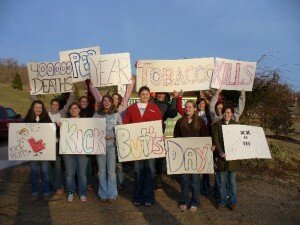Besides the second day of spring, did you know that March 21, 2012 is also Kick Butts day? Not familiar with Kick Butts Day? Well…
Kick Butts Day is a day for activism when thousands of youth in every state and around the world will stand out, speak up, and seize control against tobacco. If you are a teacher, a parent running a scout troop, or a youth leader, you can hold your own Kick Butts Day event as well.
Here are 5 ways you can kick butt on Kick Butts Day!
-
Host a cigarette b
 utt clean-up! Do you constantly see cigarette butts thrown on sidewalks, parks, beaches and other public property? Are you sick of this unnecessary litter? Well, this activity is just for you! You can organize a cigarette butt clean-up to raise awareness of the effects of discarded cigarette butts! Gather volunteers and Collect cigarette butts in garbage bags and count them along the way. Make sure everyone wears gloves!
utt clean-up! Do you constantly see cigarette butts thrown on sidewalks, parks, beaches and other public property? Are you sick of this unnecessary litter? Well, this activity is just for you! You can organize a cigarette butt clean-up to raise awareness of the effects of discarded cigarette butts! Gather volunteers and Collect cigarette butts in garbage bags and count them along the way. Make sure everyone wears gloves! - Remind your community of the cost of a carton of cigarettes! Find the average price of a pack of cigarettes in your community. Calculate the costs for a week, a month, a year, five years, etc. for a person who smokes a pack of cigarettes a day. Display the financial cost of smoking. Be creative. You can put up posters, use fake dollar bills, or turn the activity into a worksheet to be completed in class.
-
Do a door decorating contest! Get your entire school involved by challenging all of the classrooms to decorate their doors with a Kick Butts Day theme. At the end of the contest, select students or teachers to judge the doors. Award prizes to different categories, such as the most creative or the strongest message. The prizes can be anything you’d like, in order to incentivize involvement (as long as it’s approved by the school), such as a pizza party for the winning classroom.

- Restaurant placemats, table tents, and take-out stickers! Contact local restaurants to see if they would be willing to use placemats, table tents, or take-out stickers that can be placed on pizza boxes and take-out bags with your message on them. This can reach countless people and is an opportunity to form lasting relationships with community businesses.
- Kick butts with art! Host an anti-tobacco art contest. All entries should be related to the fight against tobacco, such as the harmful effects of tobacco products. You decide what types of art will be accepted, but it can be anything, including songs, photography, or poetry. Award prizes to the winners. If possible, put the winning pieces on display.
Understanding the harms of cigarette smoking is essential to youth as they mature. We hope that the positive activities will provide you with fun ways to spread the message about the effects of tobacco usage.


 To illustrate this point, the article resurfaces an old story of community impact.
To illustrate this point, the article resurfaces an old story of community impact.


